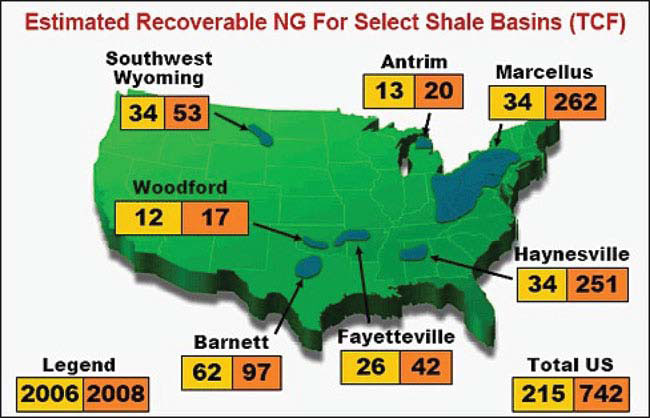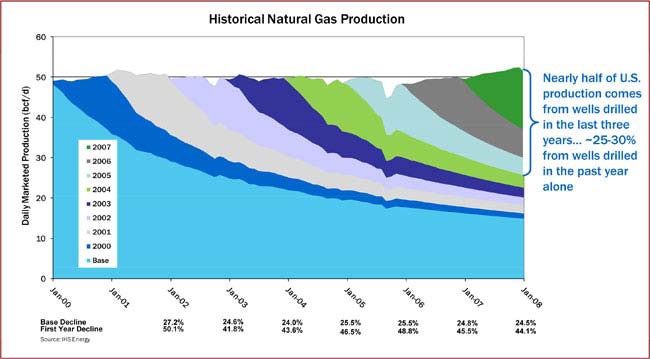Is Natural Gas Cheap?
By David Galland
Casey Research
July 25th, 2009
At the height of its
late 2005 rally, natural gas in the U.S. was selling for just over $16/MMBtu, 350% higher than today’s price of $3.56.
The oil/gas ratio, now over 18, is an all-time high… suggesting that natural
gas is dirt cheap. So, it’s a buy, right?
In a phrase, not
exactly.
According to a recent report by Natural Gas Intelligence, U.S. natural
gas available for production “has jumped 58% in the past four years, driven by improved drilling techniques
and the discovery of huge shale fields in Texas, Louisiana, Arkansas and
Pennsylvania, according to a report issued Thursday by the nonprofit Potential
Gas Committee (PGC).”
According to the report, the increase in gas discoveries and
production improvements means that North America shouldn’t have to be concerned
about gas supplies for up to 100 years!
Dr. Marc Bustin provided an overview of the situation in the May edition of
Casey Energy Opportunities.
In the United States, the
tremendous growth in natural gas resources and estimated recoverable natural
gas, particularly from gas shales, just in the last two years (Figure 1) is
sending tremors through the entire industry. These tremors include the risk of
making obsolete the proposed $26 billion Alaskan and $16 billion northern
Canadian pipelines to tap northern gas resources and a slue of proposed LNG
terminals... unless they are for export!
The numbers currently kicked around are that something
around 2,000 trillion cubic feet of gas are technically recoverable in the
United States. At current production rates, this supply would last about 90
years.
Some analysts are predicting that even if the U.S. economy
recovers in the next year, the amount of gas discovered to date in gas shales
will severely dampen any increase in gas price for some time. According to a
new study by energy consulting firm CERA (Cambridge Energy Research Associates),
new technologies for unconventional gas fields are being applied so
successfully that supply is essentially no longer a driver in either production
or price in the North American gas market – whatever the market wants, North
American gas fields can supply. CERA reports that natural gas production in the
Lower 48 states has risen a startling 14% from 2007 to 2008, for example.

Figure 1. Major
shale areas or formations in the U.S. and the estimated recoverable natural gas
in 2006
and 2008. Modified from Daily Oil Bulletin (May 4, 2009).
Given the increase in production and the small slide in
demand, the price of natural gas has fallen to around $3.50-$4.00 per MMBtu
(down from $13 per MMBtu last summer). At these prices, many gas prospects are
uneconomic, and thus there has been a marked decline in the number of wells
being drilled. Rig activity (how many rigs are operating) is down about 50% in
North America.
But here is where an interesting feedback mechanism kicks
in. One of the characteristics of unconventional shale gas wells, and to a
lesser extent natural gas wells in general, is that the production rate
declines through time. Most shale wells’ production rates decline 60 to 90% in
the first year. If you were a gas company trying to survive amidst today's low
prices, the rate of return on your capital investment would also be painfully
low for a significant amount of gas if this were your initial year of
production.
Another complementary fact is that over 50% of natural gas
consumed in the United States today is from wells drilled less than three years
ago, and 25-30% of the gas produced today comes from wells drilled last year
(Figure 2).
Hence it follows that if there are 50% fewer wells drilled
this year (from the drop in rig activity), new production will decline about
35-40% by the end of the year, so there will be gas shortages. Those will in
turn lead to higher North American prices, which in turn should lead to
additional drilling.

Figure 2. Historical
gas production in the U.S. showing the percentage of production from vintage of
well
(modified from Chesapeake April 2009 Investor presentation from original
data of HIS Energy)
Everything else being equal (which it's not, this being the
real, not the mathematical world), gas prices and drilling will see-saw until
an equilibrium is reached. In detail, of course, things are more complicated,
but it is pretty clear that gas prices will have to rise within the year, and
the big losers will remain the more expensive plays that require higher gas
prices to be economic.
Where will the gas price end up in the short term? A poll of
analysts by Reuters suggests $6 MMBtu in 2010 (Daily Oil Bulletin, May 4,
2009), but I don’t think I would bet on a gas price based on a vote by
analysts. At the same time, it's an interesting coincidence (or not –
coincidence, that is) that many prospects become economic at around the $6
MMBtu range. Among them are the Haynesville and Marcellus shales – and it's no
large leap from there to see their tremendous gas production potential acting
as a buffer to gas prices going much higher in the near term.
Thus, while there may
be some seasonal and relatively short-term trading opportunities in natural
gas, the overhang of ready supply places a fairly firm cap on the price. Which
begs the question, which big-trend energy opportunities should be getting our
attention today?
Marin Katusa, who heads the Casey Research energy team, answers the
question by, correctly, cataloging the opportunities according to geography.
In North America
1. Geothermal -- the
most interesting of the alternative energy sources, by a wide margin.
2. Nuclear.
3. Oil.
In Europe
1. Unconventional gas has, by far, the
most upside.
2. Unconventional
oil.
3. Small hydro (such
as run of river).
In Africa
First and foremost, you want to avoid infrastructure
plays (pipelines, refineries, etc). Then you want to look for areas with huge
oil potential, which have been held off the market by concerns over political
risk. I like what Lukas Lundin is doing in Ethiopia, Somalia, and Kenya,
hunting for “elephants” with the idea of eventually selling the discoveries off
to the Chinese.
In Asia,
1. Liquid Natural Gas
(LNG)
2. Coal Bed Methane (CBM)
Lessons to Learn
There are a couple of
useful lessons to be derived by investors looking to tap into the virtually
unlimited opportunities in energy.
First, just because
something is “cheap” doesn’t mean it can’t stay cheap, regardless of historical
ratios -- if there has been a fundamental shift in the supply/demand equation.
Which is very much the case with North American natural gas.
Secondly, geological
and transport considerations make much of the energy complex a “local” market.
For example, while
North America enjoys an abundance of natural gas, Europe is forced to rely on
the heavy-handed Russians for the bulk of supplies. As you read this, there are
companies looking to break the Russian grip by applying the same unconventional gas technologies that
have so successfully built gas supplies in the U.S. -- technologies that are
only just now being applied in Europe. Early investors could reap huge profits.
In short, the real
opportunities are not found by simply “investing in energy” but rather by
taking the time to understand the structural differences within the energy
complex and cherry picking the special situations that invariably exist in a
sector this large.
David Galland is the managing director of Casey Research, LLC., a private
research firm providing independent analysis and investment recommendations to
individual and institutional investors in North America and over 100 other
countries around the globe. To learn more about the monthly Casey Energy Opportunities advisory,
including a special three-month,
fully guaranteed trial subscription, click here now.
By David Galland
Casey Research
July 25th, 2009
